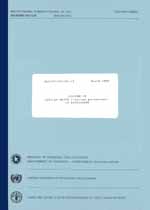
FIELD DOCUMENT
INSTITUTIONAL STRENGTHENING IN THE FISHERIES SECTOR
| BGD/87/045/92/19 | March 1992 |
 |
CULTURE OF AFRICAN MAGUR (Clarias gariepinus) IN BANGLADESH |
Prepared
by
M. MOKHLESUR RAHMAN
and
IMRE VARGA
DEPARTMENT OF FISHERIES, GOVERNMENT OF BANGLADESH
UNITED NATIONS DEVELOPMENT PROGRAMME
FOOD AND AGRICULTURE ORGANIZATION OF THE UNITED NATIONS
In an experimental and demonstration study, production parameters and economics of African magur. (Clarias gariepinus) culture, adopting different grow-out techniques in five government and two private farms, were investigated.
Semi-intensive culture techniques were used in undrainable ponds. Using locally available cheap feed ingredients (slaughter house by-products, oil cakes, rice polish/bran etc.) moist fish feed were prepared. The feed conversion ratio varied from 2.83 to 3.53 kg moist feed, to 1 kg fish in magur dominated polyculture, 4.87 to 5.53 to 1 kg of fish in magur monoculture; and 0.89–5.42 to 1 kg of fish in the chicken-magur integrated culture system.
Estimated net production of 10–12 t/ha/yr, 7.3–15 t/ha/yr and 14.2– 14.3 t/ha/yr were achieved under magur dominated polyculture, magur polyculture integrated with chicken and magur monoculture systems respectively. The fish production per unit area basis could be increased with the stocking of surface feeder species such as Silver carp (Hypophthalmichthys molitrix) and Catla (Catla catla) without affecting the growth rate of magur.
The highest net return over operating costs (90.12 %) was obtained in magur dominated polyculture system.
Hyperlinks to non-FAO Internet sites do not imply any official endorsement of or responsibility for the opinions, ideas, data or products presented at these locations, or guarantee the validity of the information provided. The sole purpose of links to non-FAO sites is to indicate further information available on related topics.
This electronic document has been scanned using optical character recognition (OCR) software. FAO declines all responsibility for any discrepancies that may exist between the present document and its original printed version.